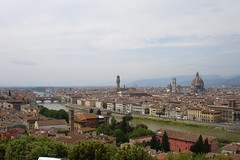I read Arthur Golden’s novel, on which the film is based, several years ago, so was looking forward to seeing the film, but was also concerned that they may not do the book justice. It is not an easy task to translate a 400 page novel into a 2 hour and 19 minute film, and a certain amount of artistic licence needs to be used. For those who have read the book, the early years of Sayuri are very similar, obviously the years of geisha training have to be condensed somewhat, but once she is a practicing geisha the story does differ, although the main characters are still present.
For those not familiar with the story, it starts off with a young girl called Chiyo who, along with her sister, is sold by her father. The girls are separated in Kyoto, where they end up and Chiyo ends up in the Okia (geisha house) of Mother as a servant working with another young girl, Pumpkin, and the spiteful Hatsumomo, who is one of the most popular geishas in the city. Both girls wish to train as geisha but it was not an easy path for Chiyo to decide to follow until she meets the charming Chairman. She is taken under the wing of another popular geisha, Hatsumomo’s rival Mameha and so her story begins in earnest as she becomes Sayuri the geisha.
The film attracted a lot of criticism and was banned in China because of the choice of using Chinese actresses to play the geisha, claiming it was insensitive considering Japanese atrocities in China in the 1930s and 40s and the fact the geishas had low morals (although they weren’t prostitutes in the traditional sense, men paid for their company and musical skills. However, their virginity was often sold to the highest bidder). The reason for the casting of the Chinese actresses is officially given that no Japanese actresses turned up for the open auditions, although it has been speculated that there were no Japanese actresses of the international calibre and status of the Chinese and Malaysian ones that were cast. The role of Sayuri as an adult is taken by Ziyi Zhang of House of Flying Daggers. The beautiful Li Gong (Farewell my Concubine) played Hatsumomo, whilst Michelle Yeoh plays Mameha, and starred in Crouching Tiger, Hidden Dragon and the James Bond film Tomorrow Never Dies. Ken Watanabe (The Last Samurai) played the supposedly charismatic chairman. I struggled with some of these performances. Firstly, English was not the first language of a lot of the cast, and in some instances I found the diction quite poor and it seemed that lines were being said sometimes by rote. I almost put the subtitles up so I could be sure of catching all the dialogue. Secondly, and this is often the case in book adaptations, they are not given the opportunity to explore the character in depth making for shallow performances. Half the emotions allegedly depicted I felt I picked up because I had read the book and understood what was being portrayed, I am not sure I would have got any depth from the film if I did not have this prior knowledge. I am not sure there was any depth to this film to be honest. My friend who had not read the book, possibly enjoyed the film more than I did, as it is always going to compare unfavourably with the book from my perspective.
Rob Marshall, the director, did a passable job of making this film come to life and there are some stunning dance sequences (he has a dance background having worked as a dancer, and previously directed Chicago). He offered an interesting snapshot into geisha life, but it is ultimately nothing more than just a glimpse as he tried to concentrate on a supposed love story that was so rushed you felt you had missed the connection (a few meaningful looks had to suffice).
The film was nominated for six technical Oscars, and won three, for best Achievement in Cinematography, art direction and costumes. The other nominations were for Sound, Sound editing and music. John Williams composed the score, and is one of the most celebrated composers in Hollywood having done the music for most of the big films such as Star Wars, War of the Worlds and Harry Potter. I can’t say the music really stuck out for me, although is did win him several other awards, including a BAFTA and a Golden Globe.
The film has a running time of 139 minutes and a certification of 12, which I think is fair. There are some limited sex scenes, but no real nudity.
Extras
The DVD has a good selection of extras that certainly appeal to those that want to learn more about the geisha and bringing the story to film. There is an audio commentary (which I didn’t listen to) by Director Rob Marshall and co-producer John De Luca plus several short films of about ten to fifteen minutes each which are quite interesting:
Geisha Boot camp – this is where the child and adult actresses spent a month learning to walk, dance and move like a Geisha. The non-English speaking actresses also had English lessons.
Sayuri’s Journey from Novel to screen – interview with author Arthur Golden and Robin Swicord who wrote the screenplay in how the 400 page book was “interpreted” (their words) for the screen.
The Look of a Geisha – explains the work involved in the costume and make up department in making the Geisha look true to life whilst trying to give it a contemporary sexiness.
Others include the World of the Geisha and the Geisha’s Dance which I didn’t watch (it was getting late!) but I would expect them to be as informative as the others. There were also several picture galleries of costume sketches and behind the scenes photos, which I didn’t find that interesting. Rather unusually there were also Japanese recipes, I didn’t try any, and they seemed quite hard to read off the screen.
Overall whilst I was disappointed in the film, I still enjoyed it and was glad I watched it. The extras, for a change, were really worthwhile and to some extent were more interesting than the film, if you wanted to learn a bit more about the geisha and the film’s background. I would not let the fact you have not read the book put you off, I think you may enjoy it more than those who had and are forever going to compare it to such a stunning novel.


